An Innovative Treatment Approach Using Digital Workflow and CAD-CAM Part 1: The Restoration of Endodontically Treated Molars in Children
Abstract
1. Introduction
2. Methods
2.1. Compliance with Ethical Standards
2.2. Clinical Case
3. Discussion
4. Conclusions
Author Contributions
Funding
Acknowledgments
Conflicts of Interest
References
- Einhorn DuVall, N.; Wajdowicz, M.; Brewster, J.; Roberts, H. Preparation ferrule design effect on endocrown failure resistance. J. Prosthodont. 2019, 28, e237–e242. [Google Scholar] [CrossRef] [PubMed]
- Robbins, J.W. Guidelines for the restoration of endodontically treated teeth. J. Am. Dent. Assoc. 1990, 120, 558–566. [Google Scholar] [CrossRef] [PubMed]
- Tang, W.; Wu, Y.; Smales, R.J. Identifying and reducing risks for potential fractures in endodontically treated teeth. J. Endod. 2010, 36, 609–617. [Google Scholar] [CrossRef]
- The Reference Manual of Pediatric Dentistry. Available online: https://www.aapd.org/research/oral-health-policies--recommendations/pediatric-restorative-dentistry/ (accessed on 17 February 2020).
- Seale, N.S. The use of stainless steel crowns. Pediatr Dent. 2002, 24, 501–505. [Google Scholar] [PubMed]
- Zagdwon, A.M.; Fayle, S.A.; Pollard, M.A. A prospective clinical trial comparing preformed metal crowns and cast restorations for defective first permanent molars. Eur. J. Oral Sci. 2003, 3, 138–142. [Google Scholar]
- Innes, N.P.; Ricketts, D.; Evans, D.J. Preformed metal crowns for decayed primary molar teeth. Cochrane Database Syst. Rev. 2007, CD005512. [Google Scholar] [CrossRef]
- Pissis, P. Fabrication of a metal-free ceramic restoration utilizing the monobloc technique. Pract. Periodontics Aesthet Dent. 1995, 7, 83–94. [Google Scholar]
- Bindl, A.; Mormann, W.H. Clinical evaluation of adhesively placed Cerec endocrowns after 2 years–preliminary results. J. Adhes Dent. 1999, 1, 255–265. [Google Scholar]
- Schmitter, M.; Hamadi, K.; Rammelsberg, P. Survival of two post systems–five-year results of a randomized clinical trial. Quintessence Int. 2011, 42, 843–850. [Google Scholar]
- Dejak, B.; Mlotkowski, A. 3D-finite element analysis of molars restored with endocrowns and posts during masticatory simulation. Dent. Mater. 2013, 29, e309–e317. [Google Scholar] [CrossRef]
- Belleflamme, M.M.; Geertsa, S.O.; Louwette, M.M.; Grenade, C.H.; Vanheusden, A.J.; Mainjot, A.K. No post-no core approach to restore severely damaged posterior teeth: An up to 10-year retrospective study of documented endocrown cases. J. Dent. 2017, 63, 1–7. [Google Scholar] [CrossRef] [PubMed]
- Sedrez-Porto, J.A.; Rosa, W.L.; da Silva, A.F.; Münchow, E.A.; Pereira-Cenci, T. Endocrown restorations: A systematic review and meta-analysis. J. Dent. 2016, 52, 8–14. [Google Scholar] [CrossRef] [PubMed]
- Schwartz, R.S.; Robbins, J.W. Post placement and restoration of endodontically treated teeth: A literature review. J. Endod. 2004, 30, 289–301. [Google Scholar] [CrossRef]
- Mangano, F.; Gandolfi, A.; Luongo, G.; Logozzo, S. Intraoral scanners in dentistry: A review of the current literature. BMC Oral Health 2017, 17, 149. [Google Scholar] [CrossRef] [PubMed]
- Sonmez, N.; Gultekin, P.; Turp, V.; Akgungor, G.; Sen, D.; Mijiritsky, E. Evaluation of five CAD/CAM materials by microstructural characterization and mechanical tests: A comparative in vitro study. BMC Oral Health 2018, 18, 5. [Google Scholar] [CrossRef] [PubMed]
- Ting-Shu, S.; Jian, S. Intraoral digital impression technique: A review. J. Prosthodont. 2015, 24, 313–321. [Google Scholar] [CrossRef] [PubMed]
- Zimmermann, M.; Mehl, A.; Mormann, W.H.; Reich, S. Intraoral scanning systems—a current overview. Int. J. Comput. Dent. 2015, 18, 101–129. [Google Scholar]
- Mangano, F.G.; Hauschild, U.; Veronesi, G.; Imburgia, M.; Mangano, C.; Admakin, O. Trueness and precision of 5 intraoral scanners in the impressions of single and multiple implants: A comparative in vitro study. BMC Oral Health 2019, 9, 101. [Google Scholar] [CrossRef]
- Albdour, E.A.; Shaheen, E.; Vranckx, M.; Mangano, F.G.; Politis, C.; Jacobs, R. A novel in vivo method to evaluate trueness of digital impressions. BMC Oral Health 2018, 18, 117. [Google Scholar] [CrossRef]
- Koch, M.J.; Garcia-Godoy, F. The clinical performance of laboratory-fabricated crowns placed on first permanent molars with developmental defects. J. Am. Dent. Assoc. 2000, 131, 1285–1290. [Google Scholar] [CrossRef]
- Means, C.R.; Flenniken, I.E. Gagging—A problem in prosthetic dentistry. J. Prosthet. Dent. 1970, 23, 614–620. [Google Scholar] [CrossRef]
- Almeida e Silva, J.S.; Erdelt, K.; Edelhoff, D.; Araújo, É.; Stimmelmayr, M.; Vieira, L.C.; Güth, J.F. Marginal and internal fit of four-unit zirconia fixed dental prostheses based on digital and conventional impression techniques. Clin. Oral Investig. 2014, 18, 515–523. [Google Scholar] [CrossRef] [PubMed]
- Tsirogiannis, P.; Reissmann, D.R.; Heydecke, G. Evaluation of the marginal fit of single-unit, complete-coverage ceramic restorations fabricated after digital and conventional impressions: A systematic review and meta-analysis. J. Prosthet. Dent. 2016, 116, 328–335. [Google Scholar] [CrossRef]
- Mittal, H.C.; Goyal, A.; Gauba, K.; Kapur, A. Clinical Performance of Indirect Composite Onlays as Esthetic Alternative to Stainless Steel Crowns for Rehabilitation of a Large Carious Primary Molar. J. Clin. Pediatr. Dent. 2016, 40, 345–352. [Google Scholar] [CrossRef] [PubMed]
- Nagasiri, R.; Chitmongkolsuk, S. Long-term survival of endodontically treated molars without crown coverage: A retrospective cohort study. J. Prosthet. Dent. 2005, 93, 164–170. [Google Scholar] [CrossRef] [PubMed]
- Fayle, S.A. Molar incisor hypomineralization: Restorative management. Eur. J. Paediatr. Dent. 2003, 4, 121–126. [Google Scholar]
- Mahoney, E.K. The treatment of localized hypoplastic and hypomineralized defects in first permanent molars. N. Z. Dent. J. 2001, 97, 101–105. [Google Scholar]
- Radcliffe, R.M.; Cullen, C.L. Preservation of future options: Restorative procedures on first permanent molars in children. J. Dent. Child. 1991, 58, 104–108. [Google Scholar]
- Randall, R.C. Preformed metal crowns for primary and permanent molar teeth: Review of the literature. Pediatr. Dent. 2002, 24, 489–500. [Google Scholar]
- Harley, K.E.; Ibbetson, R.J. Dental anomalies: Are adhesive castings the solution? Br. Dent. J. 1993, 174, 15–22. [Google Scholar] [CrossRef]
- Hunter, L.; Stone, D. Supraoccluding cobalt-chrome onlays in the management of amelogenesis imperfecta in children: 12-year case report. Quintessence Int. 1997, 28, 15–19. [Google Scholar] [PubMed]
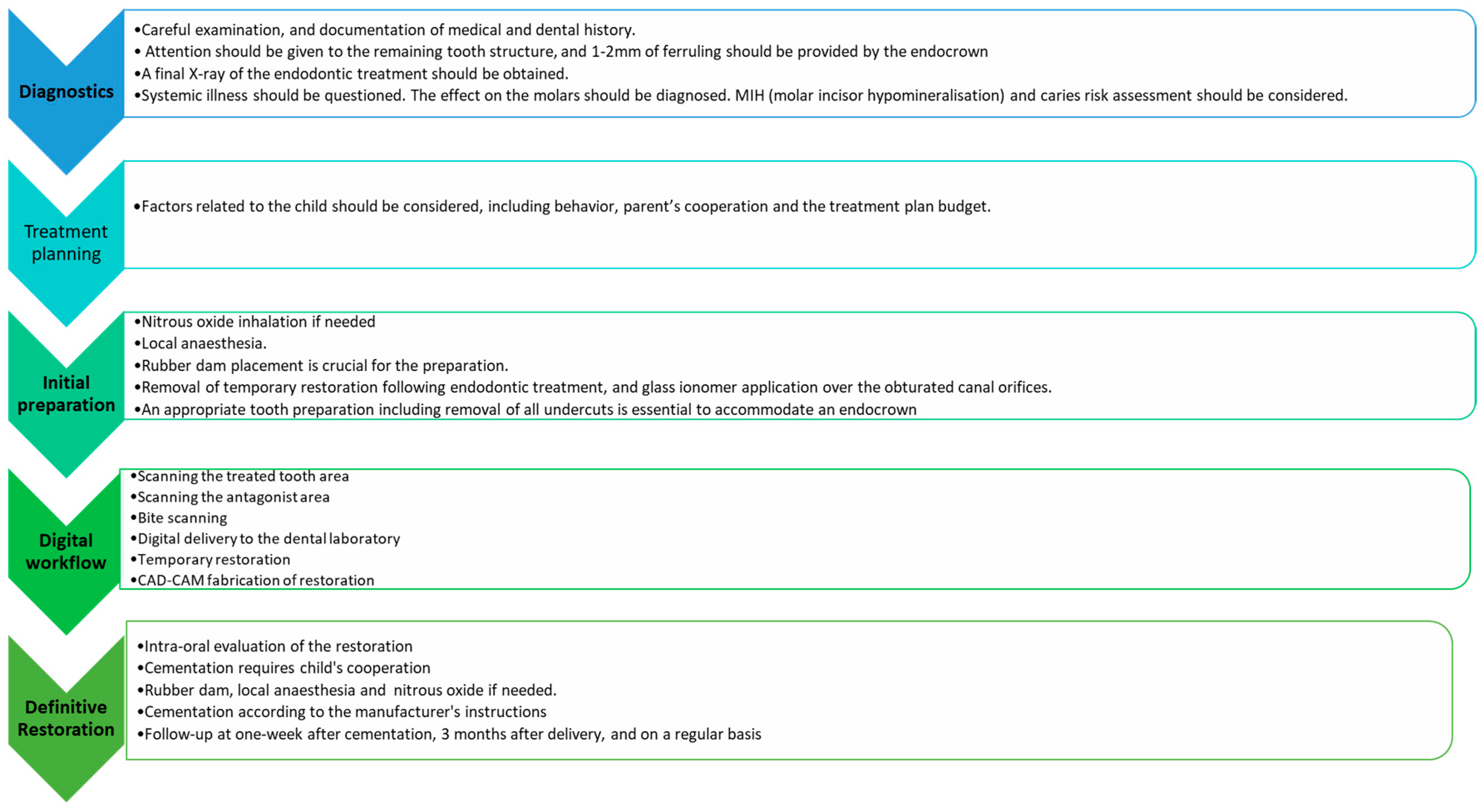
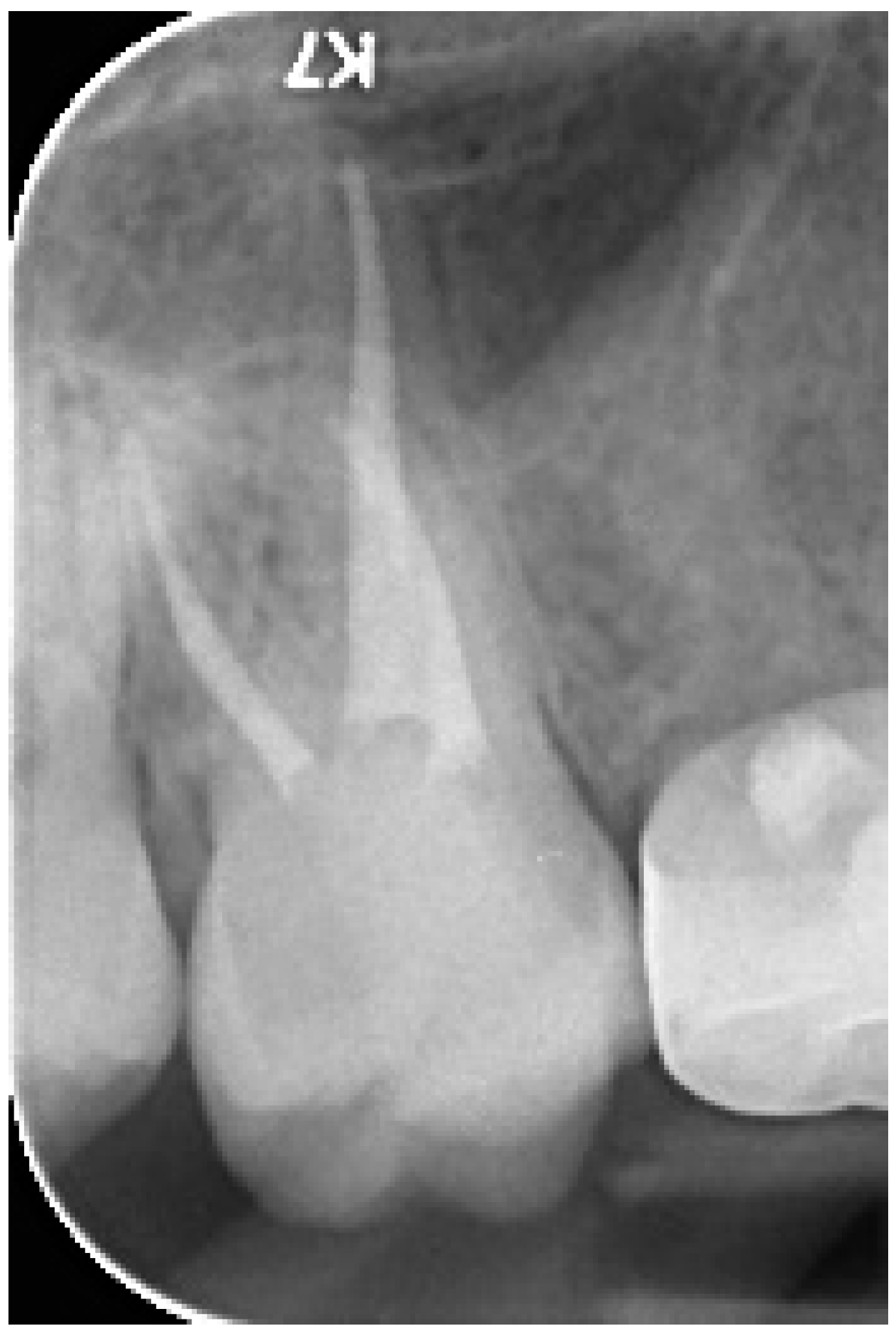
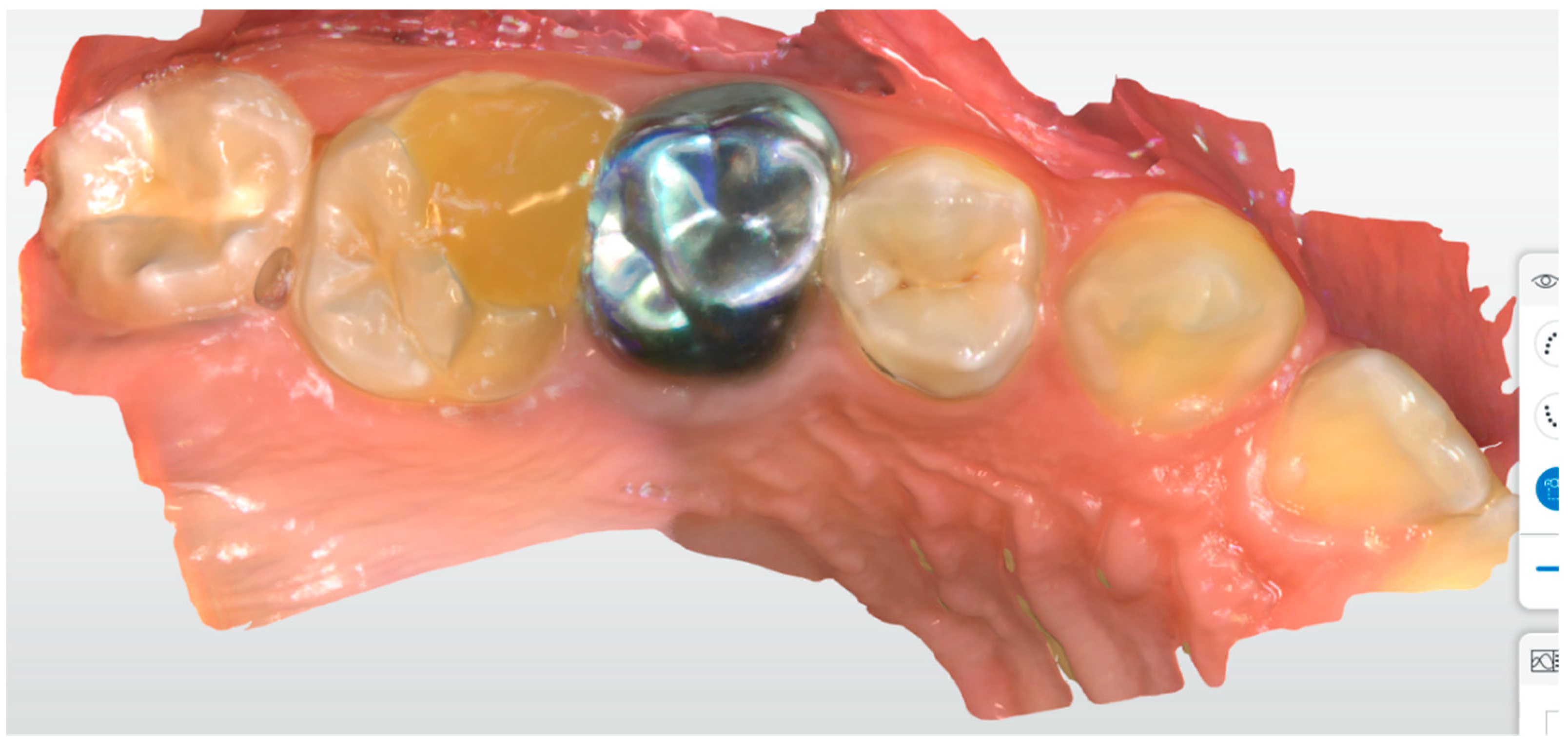

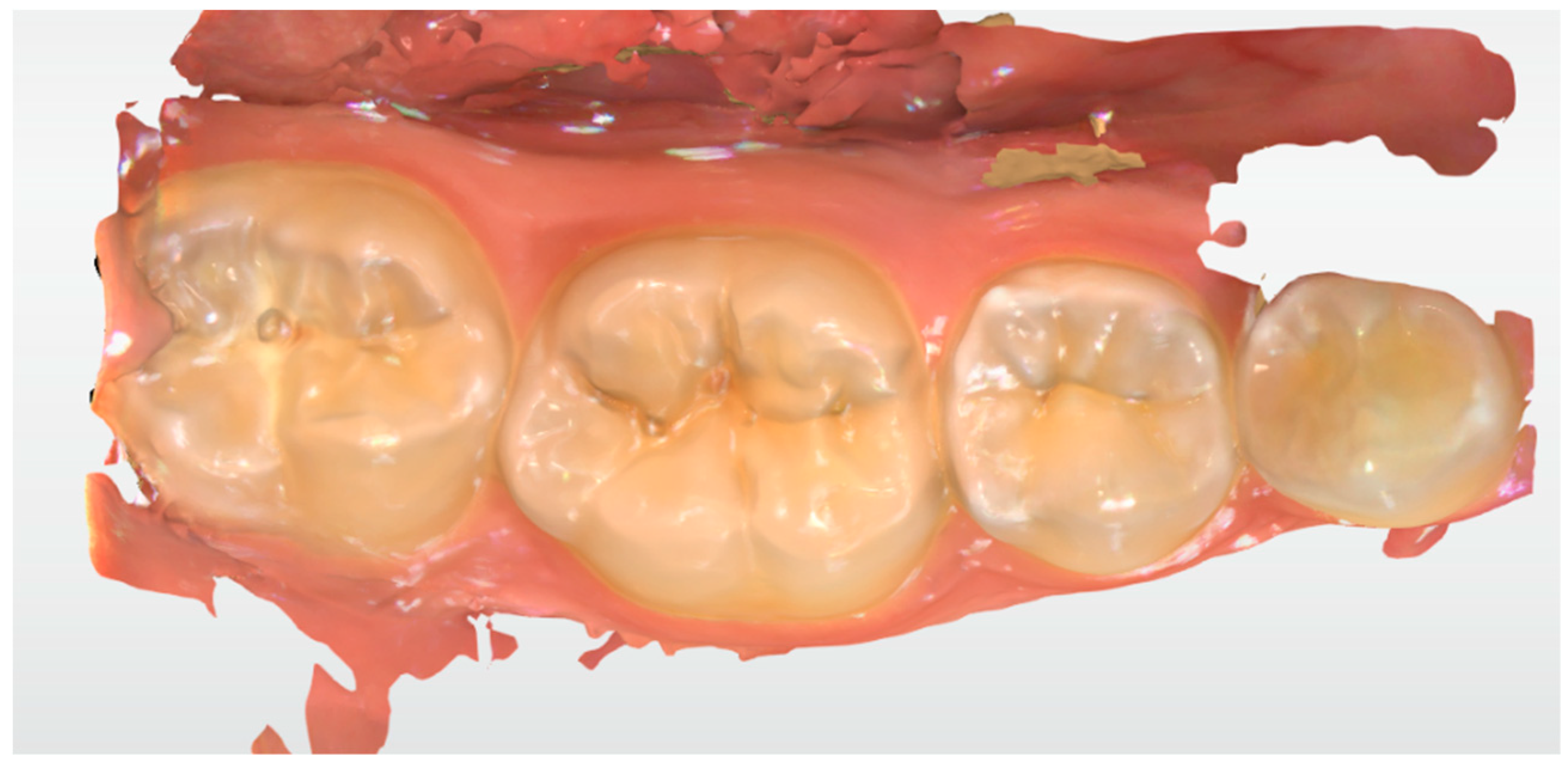
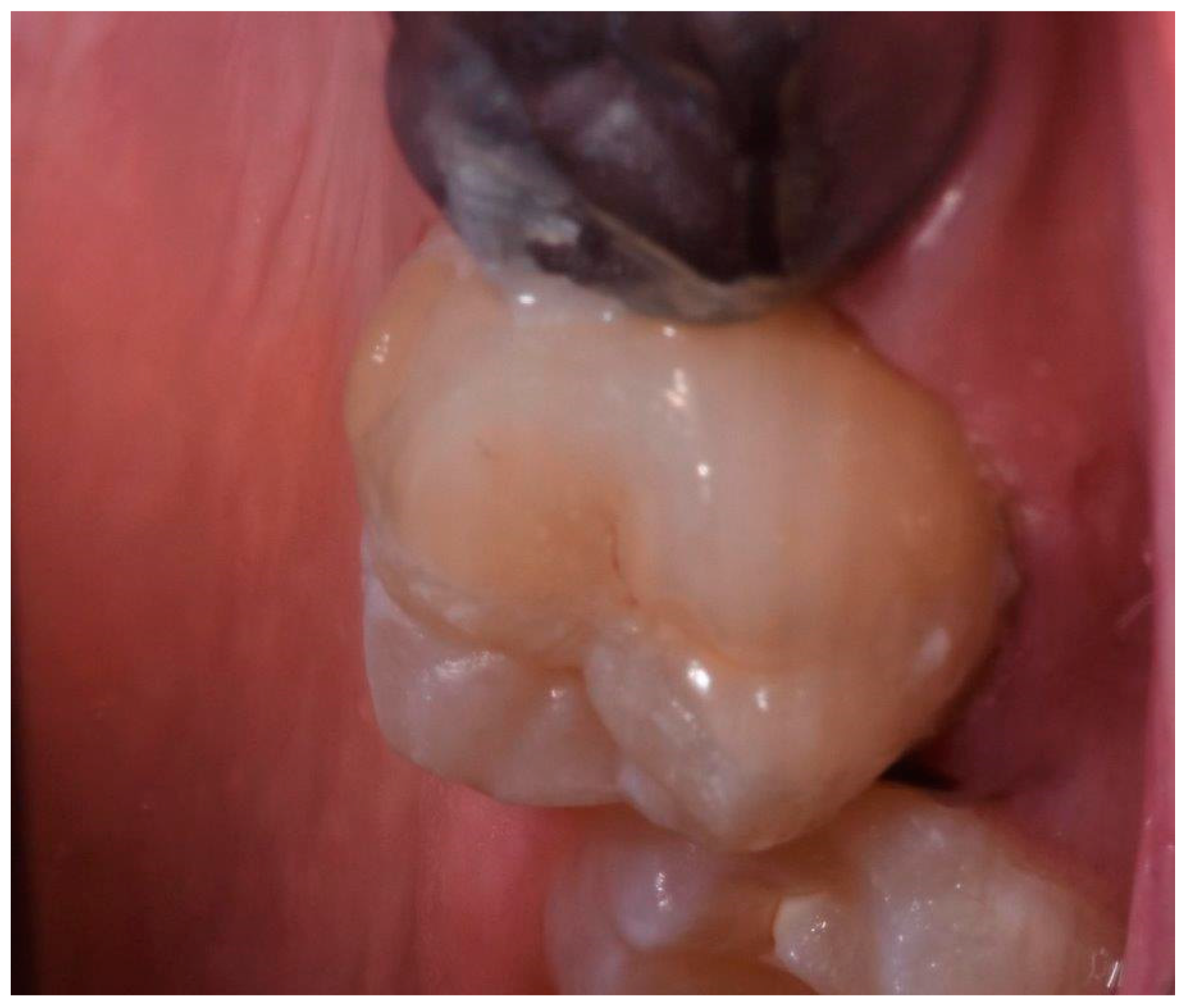
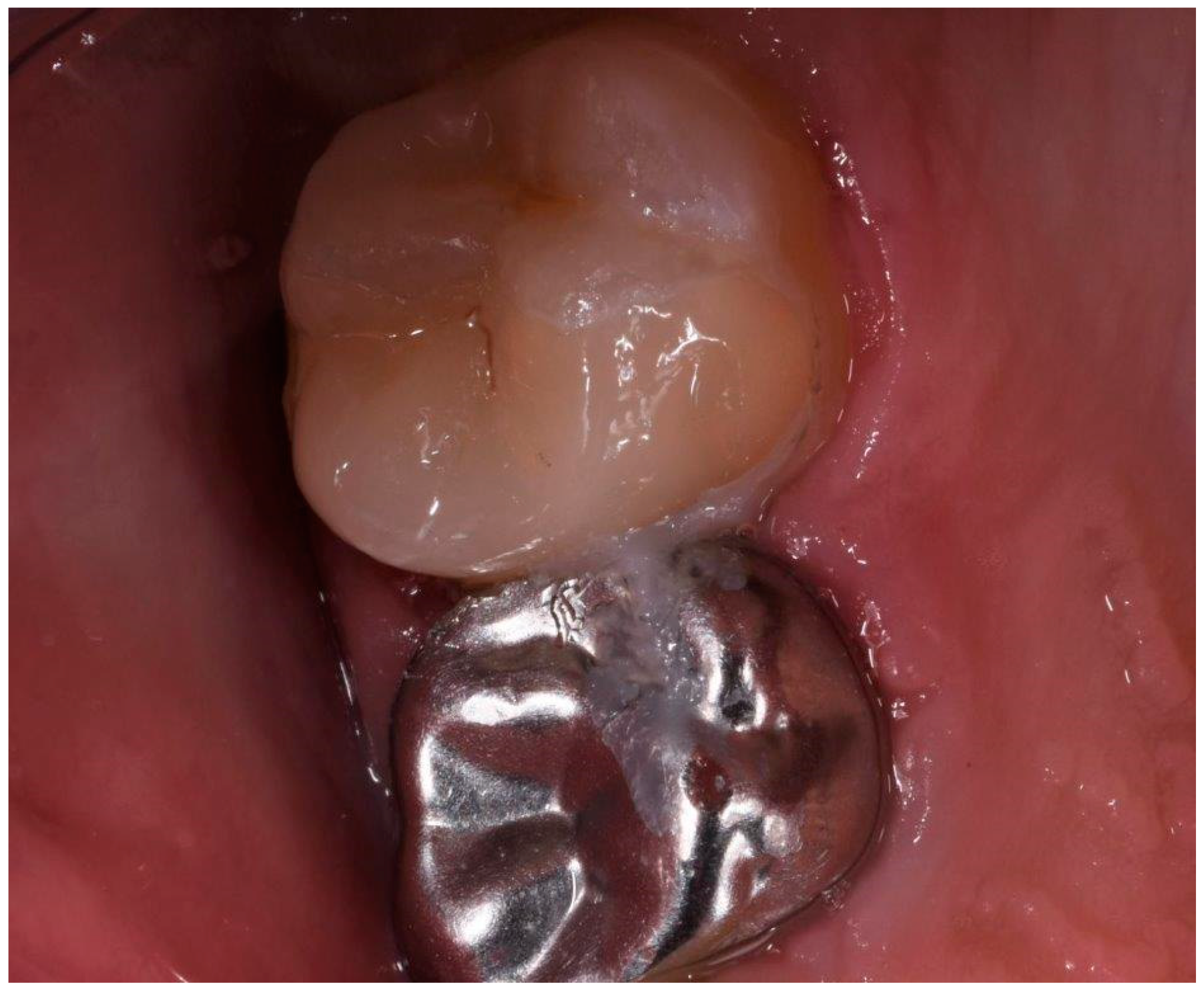
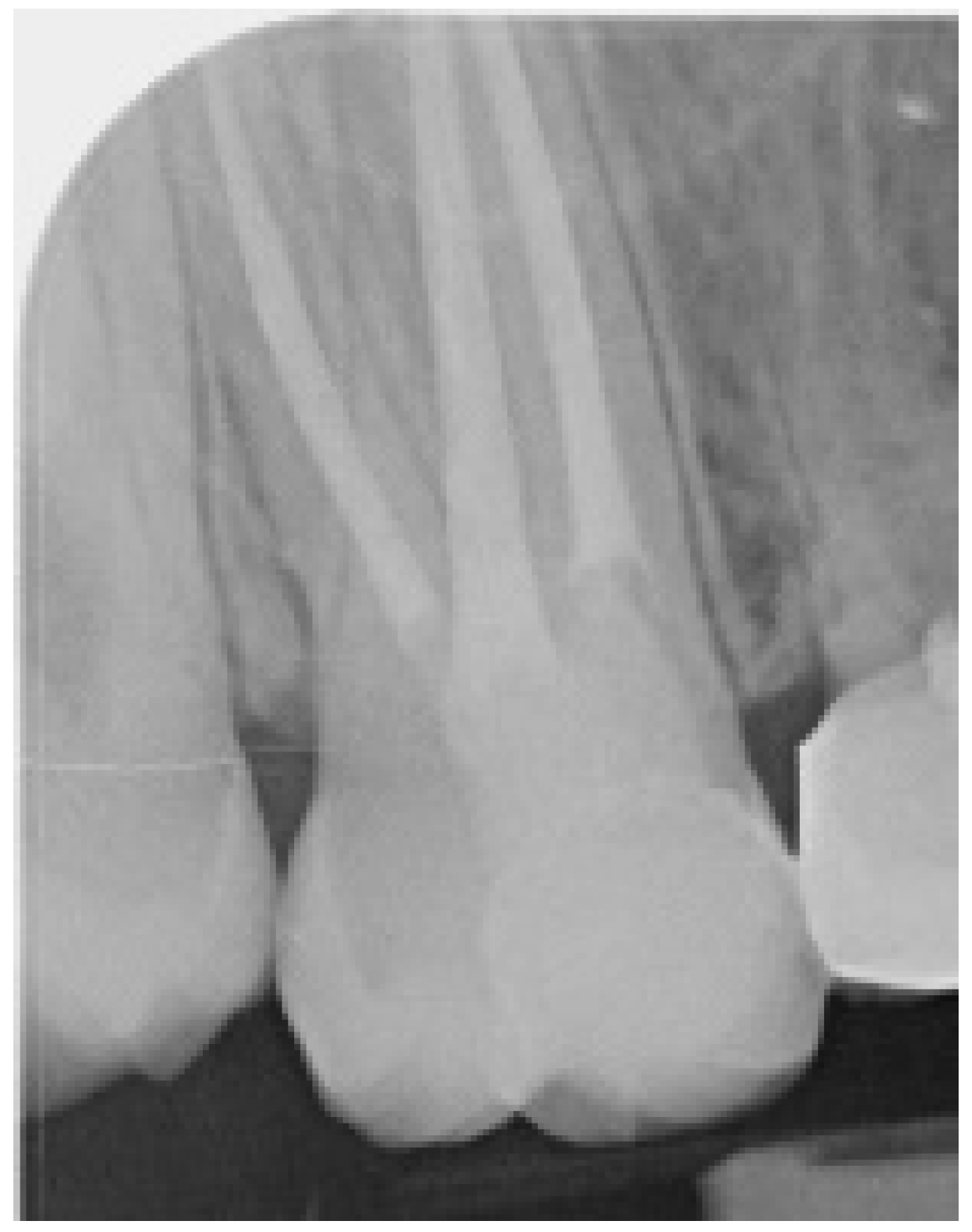
| Restorative Considerations | Composite Restoration | Full Coverage Stainless-Steel Crown | CAD/CAM Ceramic Endocrown |
|---|---|---|---|
| Effectiveness of restorative approach | ++ | +++ | +++ |
| Tooth preparation | ++ | + | ++ |
| Restoration strength (shear & bond) | ++ | +++ | +++ |
| Occlusal contact stability | ++ | +++ | +++ |
| Interproximal contact stability | ++ | +++ | +++ |
| Aesthetics | ++ | - | +++ |
| Technique sensitivity | ++ | +++ | ++ |
| Cost | ++ | ++ | + |
| Predictability | + | +++ | +++ |
| Need for definitive restoration | + | - | +++ |
| Restoration longevity | ++ | +++ | +++ |
© 2020 by the authors. Licensee MDPI, Basel, Switzerland. This article is an open access article distributed under the terms and conditions of the Creative Commons Attribution (CC BY) license (http://creativecommons.org/licenses/by/4.0/).
Share and Cite
Davidovich, E.; Shay, B.; Nuni, E.; Mijiritsky, E. An Innovative Treatment Approach Using Digital Workflow and CAD-CAM Part 1: The Restoration of Endodontically Treated Molars in Children. Int. J. Environ. Res. Public Health 2020, 17, 1364. https://doi.org/10.3390/ijerph17041364
Davidovich E, Shay B, Nuni E, Mijiritsky E. An Innovative Treatment Approach Using Digital Workflow and CAD-CAM Part 1: The Restoration of Endodontically Treated Molars in Children. International Journal of Environmental Research and Public Health. 2020; 17(4):1364. https://doi.org/10.3390/ijerph17041364
Chicago/Turabian StyleDavidovich, Esti, Boaz Shay, Eyal Nuni, and Eitan Mijiritsky. 2020. "An Innovative Treatment Approach Using Digital Workflow and CAD-CAM Part 1: The Restoration of Endodontically Treated Molars in Children" International Journal of Environmental Research and Public Health 17, no. 4: 1364. https://doi.org/10.3390/ijerph17041364
APA StyleDavidovich, E., Shay, B., Nuni, E., & Mijiritsky, E. (2020). An Innovative Treatment Approach Using Digital Workflow and CAD-CAM Part 1: The Restoration of Endodontically Treated Molars in Children. International Journal of Environmental Research and Public Health, 17(4), 1364. https://doi.org/10.3390/ijerph17041364






